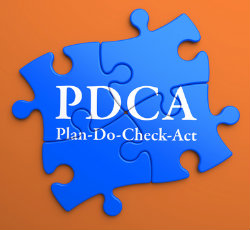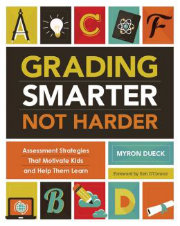 By Myron Dueck
By Myron Dueck
Change can be difficult. We find ourselves entrenched in old habits, and, therefore, much of what we do is simply what we have always done. However, there is often an even bigger hurdle to leap when it comes to change—we simply don’t see the need for it.
A home-improvement friend of mine suggested that I get someone unfamiliar with my home to point out things that could use a little TLC. This friend told me, “Myron, you don’t notice things that jump out at me immediately—you are oblivious to the familiar.”
 He suggested two changes for my home and, after I recovered from the subtle sting of criticism, I appreciated the analysis. It wasn’t that I was unwilling to fix my dog-chewed doorframe, but, ironically, I saw it so often that I did not actually see the problem. I think the same issue exists in schools.
He suggested two changes for my home and, after I recovered from the subtle sting of criticism, I appreciated the analysis. It wasn’t that I was unwilling to fix my dog-chewed doorframe, but, ironically, I saw it so often that I did not actually see the problem. I think the same issue exists in schools.
Grading Smarter Starts with Awareness
For many teachers, what stands in the way of change is not a lack of willingness but a lack of awareness. My own experience in this area served as the impetus for writing Grading Smarter, Not Harder:Assessment Strategies that Motivate Kids and Help Them Learn. In some respects, I could have titled the book Things I Never Noticed Before.
With that idea in mind, here are a few epiphanies I’ve had along the road to better teaching. Each one has helped me to see the need for change and enact it effectively.

Improving Unit Plans
I never noticed that my learning targets were hidden from sight and actually quite nebulous should anyone succeed in uncovering them. To fix this oversight, I started with one single Assessment for Learning element and established clear learning intentions for it.
Based on Rick Stiggins’ work, I highlighted what students needed to know, reason, demonstrate, and produce. Those students facing heavy course loads appreciated the efficient study guide. Struggling learners found that the clear targets provided greater focus and accessibility.
Improving Unit Tests and Retests
Something else I never noticed was that my unit tests failed to give useful, specific feedback to kids.
Historically, I provided students with a single score, on a 100-point scale, that supposedly reflected their mastery of an array of learning targets. Telling a student that she had scored 72 percent on a WWII test containing a dozen targets was tantamount to my doctor informing me that I was 72 percent healthy following my physical. What good is that information? My students needed to know how they were performing on each individual target and I needed to know how effectively I was I teaching each target.
 I decided to dismantle and rebuild my unit tests, dividing them into sections based on individual learning targets. My last step was to design a “sister test” that mirrored the first one in every way, except with different questions, to serve as a retest for students who wanted to retake one or more sections.
I decided to dismantle and rebuild my unit tests, dividing them into sections based on individual learning targets. My last step was to design a “sister test” that mirrored the first one in every way, except with different questions, to serve as a retest for students who wanted to retake one or more sections.
This new unit test/retest strategy provided me with tangible data corresponding to individual learning targets and was a game changer in my classroom. The benefits were obvious and varied:
– Students could adapt review strategies to specific feedback.
– I could identify teaching areas that needed improvement.
– Parent-teacher interviews were based on real data.
– Previous quiz scores were rendered obsolete based on the new corresponding test section score.
– At-risk learners readily approached retests because they were less daunting.
– Exceptional learners clawing for every extra point chose retesting over lobbying.
Improving Multiple Choice Questions
A few colleagues and I noticed that multiple choice questions on tests were horribly flawed as a tool to measure understanding. We therefore coined a process called “’I know I Am Close’ Multiple Choice” by which students who had narrowed their response down to two options were given the opportunity to explain why they were considering both answers.
This rather simple process had profound results:
– It reduced stress levels for all students.
– Students were able to show a broader level of understanding.
– Students were able to identify flawed questions.
– ESL students could attempt questions and identify the terms that were unclear.
Improving Major Project Planning Sheets
A few colleagues and I wanted to further embrace project-based learning, but we soon recognized that many students were not fully grasping the learning targets. Students got so excited about the method that they often failed to really learn and understand the content.
 To resolve this issue, we asked students to indicate the learning targets they intended to coverbefore starting a project. In addition, students were asked to provide details on the methods and approaches they were going to employ in order to demonstrate understanding. Clear learning targets blended with increased opportunities for creative elements resulted in astounding projects.
To resolve this issue, we asked students to indicate the learning targets they intended to coverbefore starting a project. In addition, students were asked to provide details on the methods and approaches they were going to employ in order to demonstrate understanding. Clear learning targets blended with increased opportunities for creative elements resulted in astounding projects.
Improving Grading
With all of these changes, it soon became obvious that I was approaching a dusty show-down with my grading scheme. After exerting all of this effort to improve my unit plans, testing systems and formats, and project planning, my traditional grading scheme seemed to sabotage the valuable data I was after. I couldn’t explain why I was applying penalties that
– Had nothing to do with learning.
– Misrepresented the data that was intended to reflect student understanding.
– Unjustly penalized struggling and impoverished learners.
I realized that my penalty paradigm was antiquated and ineffective. My rules reflected what had been done to me rather than a set of guidelines intended to aid my students’ learning.
By critically analyzing my own grading rituals, I came to the conclusion that any penalty I assigned must pass four CARE conditions.
- Care–The penalty must evoke concern and action on the part of the learner.
Many students showed little or no concern over the threat of a 10 percent late penalty.
- Ambition—The enacting of the penalty must align with the ultimate objectives of the teacher.
My aim was to grade a student’s level of understanding, not his behaviors.
- Reduction— The number of times the penalty is enacted must decrease over time for a specific learner.
I seemed to be giving out zeros and late deductions like they were candy!
- Empowerment—The penalized person must have control over the causational factors that lead to the infraction.
Students living with poverty, violence, and a host of other issues may not be solely to blame for missing homework deadlines.
Based on these four conditions, and with suggestions from Ken O’Connor’s 15 Fixes for Broken Grades, I eliminated the use of zeros for missing work, axed late penalties, and stopped wasting my time grading uniform homework. For each of these changes I selected replacement routines that fit the four CARE conditions.
See-It-Yourself Improvement
In the end, I came to the realization that I was comfortable with change, so long as I recognized the need for it. I came to understand that if something was learned was more important thanwhen it was learned.
Most of all, I was surprised at how much the relationships in my class improved by altering my assessment, project, and grading methods.
 Myron Dueck is a vice principal, teacher, and author from School District 67 in British Columbia, Canada. Myron has presented in both Los Angeles and Chicago at the ASCD Annual Conference and has been published twice in Educational Leadership. His first book,Grading Smarter, Not Harder: Assessment Strategies that Motivate Kids and Help Them Learn, was published by ASCD in July 2014.
Myron Dueck is a vice principal, teacher, and author from School District 67 in British Columbia, Canada. Myron has presented in both Los Angeles and Chicago at the ASCD Annual Conference and has been published twice in Educational Leadership. His first book,Grading Smarter, Not Harder: Assessment Strategies that Motivate Kids and Help Them Learn, was published by ASCD in July 2014.
Read Myron’s Educational Leadership article on why he now allows re...
You need to be a member of School Leadership 2.0 to add comments!
Join School Leadership 2.0